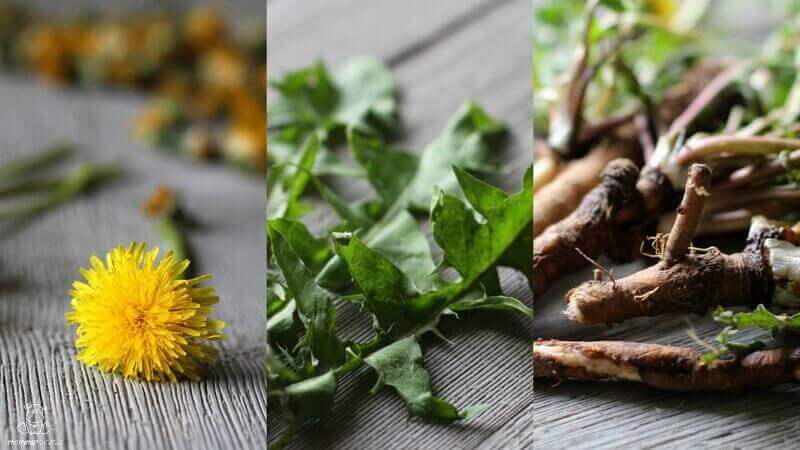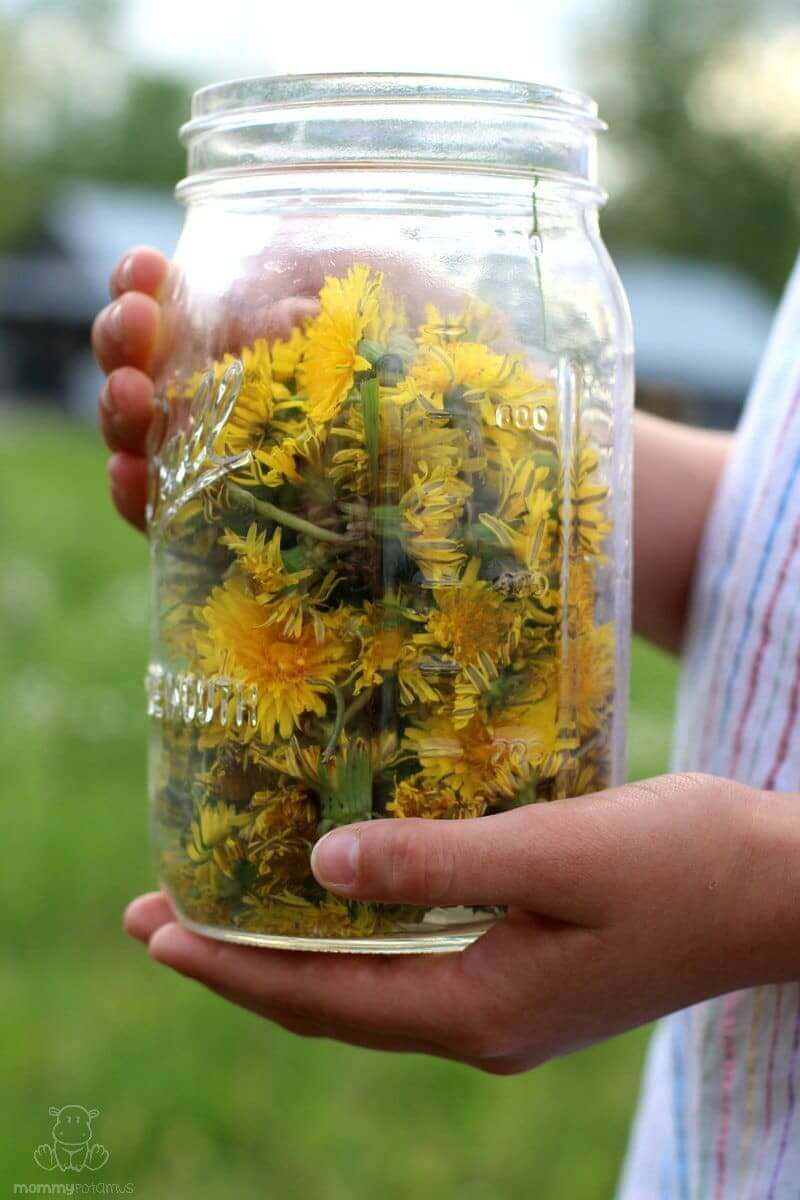
Remember the joy of closing your eyes and blowing with all your might on a dandelion puffball . . . possibly while someone nearby cringed at the thought of all those “pesky weed” seeds spreading?
Some see a weed and some see a wish, but really they’re a medicinal and culinary adventure waiting for you in your backyard.
“Dandelion is a generous plant in that every part of it can be used as food or medicine,” writes Rosalee de la Forêt in her gorgeous book, Alchemy of Herbs. And it’s true – dandelion flowers, roots and leaves can be made into nourishing salads, teas, decoctions, tinctures, syrups, wines, skin healing salves and more.
Since they’re everywhere in the spring and summer, dandelions are a wonderful way to introduce kids to the magic of herbs right in your backyard. Just make sure your dandelion harvest has not been sprayed with chemicals – that’s lesson #1 in wildcrafting for kids! Lesson #2 is how to properly identify dandelion – you can find a guide to doing that here.

So, what are the health benefits of dandelion flowers, leaves and roots?
If you’re familiar with using yellow dock as an herbal ally, this list of benefits from dandelion might look very familiar. Yellow dock and dandelion have many similar benefits. For example, both support:
- Detoxification, which is especially helpful for those of us with the MTHFR mutation
- Hormone balance
- Digestion (helping to keep things moving, nutrient absorption)
- Blood sugar balance
- Skin clarity and overall health
- Gut microbiome diversity
That’s because both dandelion, Taraxacum officinale, and yellow dock are bitters and prebiotics, which are renowned for their ability to support detoxification, liver function, digestion, and blood sugar as well as nourish the good bacteria living in our digestive tract.
But dandelions have many additional health benefits that set them apart from yellow dock, and they’re well worth including in your home apothecary.
What else are dandelions good for?
Dandelion is chock-full of useful constituents that make it a wonderful, easy-to-find herb that we can gather as needed for:
- Liver and gallbladder support due to the presence of bitter lactones
- Soothing skin irritations or using as a base for a sore muscle rub due to its anti-inflammatory properties
- Easing water retention thanks to its diuretic properties
- Skin clarity due to the detoxifying properties of the roots
- Supporting healthy respiratory function during allergy season due to the liver supporting properties of the roots
- Supporting healthy bowel function due to the bitter components
- Counteracting oxidative stress, aka the production of free radicals that lead to accelerated aging and several disease processes
- Eye health due to the antioxidant lutein, which is is one of two major carotenoids found as a color pigment in the human eye
What part of the dandelion should I use?
Dandelion roots, leaves, stems and flowers have different properties, so you’ll want to select the part you use based on your goals.

What are the benefits of dandelion leaves?
Also known as dandelion greens, the leaves are excellent for digestion. Like the roots, they contain bitter flavonoids and lactones that stimulate digestive juices such as stomach acid (HCl), bile, and enzymes so that we can break down and absorb nutrients.
To use them, just throw a few un-sprayed leaves into your dinner salad or a pesto dip. (1)
Be careful, though: the leaves can have a diuretic effect so you don’t want to eat too much of that pesto right before bed! (2) Fortunately, “unlike many pharmaceutical diuretic drugs, dandelions are naturally high in potassium and do not promote potassium excretion or deficiency.” (1)
Dandelion leaves are also packed with health supporting vitamins and minerals, including vitamin C, B-complex, beta-carotene, magnesium, iron, and calcium.

What are the benefits of dandelion roots?
Use the fresh or dried roots of dandelion to support hormone balance, digestion, liver health during allergy season, or for skin and detox issues. (2)
Like the leaves, dandelion root is also very high in minerals (iron, manganese, calcium, potassium) and nutritive compounds such as carotenes. It’s a mild laxative, contains the prebiotic inulin to feed your microbiome, and is anti-inflammatory due to the presence of taraxasterols. (3)
You can add nutritious fresh roots to soups (cook like a carrot) or make dandelion tea out of the roasted dried roots. Although roasting reduces the prebiotic inulin content, you still get all of the benefits from the minerals and liver-supportive properties. (1) (2) (4)

What are the benefits of dandelion flowers?
The sunny yellow flowers are full of anti-inflammatory antioxidants and flavanoids that support and protect your cells, vascular system, and even your eyes! (3) Also, according to this study, both dandelion flower and leaf extracts protect against UVB-related photoaging and senescence (aging at the cellular level).
To harness the power of dandelion flowers, pull off the yellow petals and throw them into a salad or make up some dandelion honey, vinegar for dressings, infused oil for skincare, or a healing skin salve.
Or you can just walk around your yard in the morning and chew up some petals as you get your burst of sunlight for circadian rhythm balance (hey, us busy mommas have to multi-task where we can)!
How to use dandelion stems and seeds
Herbalist Rosalee de la Foret ferments the stems in a true “waste-not, want-not” fashion. The seeds are edible as well, and you get the free wishes, of course!

Dandelion Recipes To Try
- Roasted dandelion root tea – When I first heard that roasted dandelion root is used as a coffee substitute, I immediately ruled it out as something I wanted or needed in my life. Because I. AM. NOT. breaking up with coffee. But this rich, creamy dandelion root tea is so delicious that I always make a double batch – one cup for me, and one to replace that cup when my littles steal away its deliciousness.
- Dandelion infused oil – This dandelion-infused oil can be used as a face moisturizer, chapped-lip balm, baby bottom balm, owie salve, burn salve, bug bite balm, and more.
- Dandelion salve – Rich in anti-inflammatory antioxidants, polyphenols and flavonoids, this dandelion salve works beautifully as an all-purpose healing balm for cuts, scrapes, burns, bug bites, chapped skin and more. It’s mixes dandelion oil with beeswax to make it easy to carry in a bag without making a mess.
- Dandelion syrup
- Dandelion vinegar
- Dandelion honey

Does dandelion have any side effects?
According to the Botanical Safety Handbook, dandelion is a Safety Class 1A herb – the safest rating possible. It is described as:
“Herbs that can be safely consumed when used appropriately.
- History of safe traditional use
- No case reports of significant adverse events with high probability of causality
- No significant adverse events in clinical trials
- No identified concerns for use during pregnancy or lactation
- No innately toxic constituents
- Toxicity associated with excessive use is not a basis for exclusion from this class
- Minor or self-limiting side effects are not bases for exclusion from this class”
However, they note that it’s important to be careful with hypotensive drugs or other diuretics due to the diuretic effect of dandelion. If you are taking potassium-retaining drugs (ex: Lisinopril) be cautious with dandelion as it is high in potassium.
If you have gallstones, be careful with the choleretic (gall bladder-stimulating) activity of dandelion.
Dandelions may trigger allergic reactions in people who are sensitive to plants in the aster family, which includes dandelion, ragweed, daisies, marigolds, or chrysanthemums.
Always check with your healthcare professional before adding herbs to your diet, and listen to your intuition to help you make the best choice for yourself.
When to pick dandelion
The best thing about dandelion may just be how widely available it is. As long as you confirm that the location hasn’t been sprayed with chemicals, dandelion can be found in every crack and corner. There are a few look-alikes, so make sure what you are harvesting has these features:
- No spines or hairs on the leaves
- Only basal leaves (no leaves on the stems)
- One flower per stem
Here’s a picture guide to identifying dandelion and its look-alikes. Practically speaking, you can harvest any part of the plant at any time. Leaves that are young (before the plant has flowered) will be highest in vitamins and minerals, but older leaves will be higher in bitter compounds that support digestion.
Roots are best harvested earlier in the year for the bitter qualities (found on the outside of the skinnier roots), but later in fall after a freeze if you want higher levels of gut-nourishing inulin from big, starchy roots. (5)
Flowers should be harvested in the morning or early afternoon when they are still open. (6) Make sure and leave enough for the bees, and make wishes as you blow those seeds for future dandelions! If you leave pieces of the root in the ground as you harvest, the plant is more likely to regrow for a sustainable harvest in the future.
Want more research-backed natural remedies?
No problem, I’ve created a free ebook for you – Kitchen Apothecary: 25+ Natural Remedies Using Ingredients From Your Pantry – as a gift for signing up for my newsletter. You’ll also get updates when I post about safe essential oils for pregnant/breastfeeding mamas, exclusive gifts and coupons (I was able to give away a jar of free coconut oil to anyone who wanted it recently!), plus other goodies.
Sign up using the form below.
About the authors: This article was coauthored by Heather Dessinger and Dr. Lori Valentine Rose (PhD). Dr. Rose, PhD is a college biology, nutrition, herbal, and wellness instructor, Certified Nutrition Professional (CNP), Registered Herbalist with the American Herbalist Guild, and is Board Certified in Holistic Nutrition. She created, developed, and instructs the Hill College Holistic Wellness Pathway, the most thorough, affordable, degreed wellness program in the country. She loves spreading love and light, and helping others feel awesome on the inside and out so they can live their dreams and make this world more awesome!

Sources
1. de la Foret, Rosalee (2017) Alchemy of Herbs: Transform Everyday Ingredients into Foods and Remedies That Heal
2. Groves, Maria Noel (2016) Body into Balance: An Herbal Guide to Holistic Self-Care
3. Ganora, Lisa (2009) Herbal Constituents: Foundations of Phytochemistry
4. Vorderbruggen, Mark (2016) Foraging: Over 30 Tasty Recipes to Turn Your Foraged Finds into Feasts
5. Masé, Guido (2013) The Wild Medicine Solution: Healing with Aromatic, Bitter, and Tonic Plants
6. King, Jovial (2016) DIY Bitters: Reviving the Forgotten Flavor – A Guide to Making Your Own Bitters for Bartenders, Cocktail Enthusiasts, Herbalists, and More




